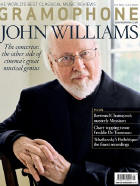Texte paru dans: / Appeared in: |
|
|
Outil de traduction |
|
|
Domenico Scarlatti is best known for the hundreds of keyboard sonatas that he composed during the latter part of his life for his pupil Maria Barbara, princess of Portugal and later queen of Spain. But he also wrote operas and church music. Almost all of the former are lost; the church music that survives includes this Stabat mater, which probably dates from his time in Rome between 1715 and 1719. Scored for 10-part choir and continuo, it lasts for some 20 minutes. There is plenty of counterpoint – ‘Fac ut animae’ is fast and fugal – but Scarlatti largely eschews block harmony. Truth to tell, the piece is rather dull, but once in a while something occurs to make you sit up. There’s a surprising, dramatic pause after the first line of ‘Quis non posset’; and at ‘Inflammatus’, soprano and tenor (the booklet note oddly says alto) engage in operatic melismas. Le Caravansérail, singing one-to-a-part, are impressively sonorous, though the distinctive tones of the countertenor Paul-Antoine Bénos-Djian are rather too prominent. The opera Amor d’un’Ombra e Gelosia d’un’aura (Rome, 1714) survives in the form of an adaptation by Scarlatti’s friend Thomas Roseingrave performed under the title Narciso in 1720 at the King’s Theatre in the Haymarket; it was part of the first season of operas promoted by the Royal Academy of Music. The three, or rather four numbers presented here (explanation to follow) are separated by some of the ‘other works’ of the disc’s title. ‘Sento, che a poco, a poco’, a ditty lamenting ‘the fire of passion’, is given a lift by a twice delayed cadence at the end of the ‘B’ section. Emmanuelle de Negri sings with a touching simplicity. Track 20 consists of a pastoral aria sung by one character in Act 2 followed by a ‘battle’ aria sung by a different character in Act 3. Bénos-Djian takes the contrast in his stride, singing sweetly and vigorously respectively. He and Negri come together sublimely for ‘Dio d’amor’, Narcissus and Echo combining in sensuous thirds: a duet worthy of the Handel who wrote ‘Io t’abbraccio’ in Rodelinda. Pur nel sonno almen tal’ora is a 19-minute cantata for soprano, two violins and continuo, to a text by Metastasio. A substantial instrumental introduction is followed by a Minuetto, charmingly played here by harp, archlute and pizzicato cello. A recitative – part secco, part accompagnato, with a violent intervention from the violins when the lover sees his rival – is enclosed by two da capo arias, the work rounded off with a powerful postlude. Negri is fiery, grippingly so. Unlike the single-movement works for keyboard, the Sonata Kk90 is in four movements, the opening Grave leading to a skittish Allegro and two short fast movements in triple time. The violinist Leila Schayegh is supported by harp, theorbo and harpsichord; the bass line would have benefited from the addition of a cello, but it’s an engaging account all the same. The Sonata Kk213, also in D minor, an Andante of exquisite sensibility, is played with a fine sense of introspection by Bertrand Cuiller. The G major Cantabile, Kk144, labelled ‘doubtful’ by Grove, is assigned to the harp of Bérengère Sardin. The disc is completed by a short Sinfonia and one of Avison’s concerto grosso arrangements. All in all, this is a fine achievement by Bertrand Cuiller and Le Caravansérail, demonstrating that there’s more to Scarlatti than those hundreds of keyboard sonatas. Predictable scattering of misprints in the booklet: none important, and I rather enjoyed the image conjured up by the reference to Scarlatti’s ‘loyal fiend Roseingrave’. |
|




